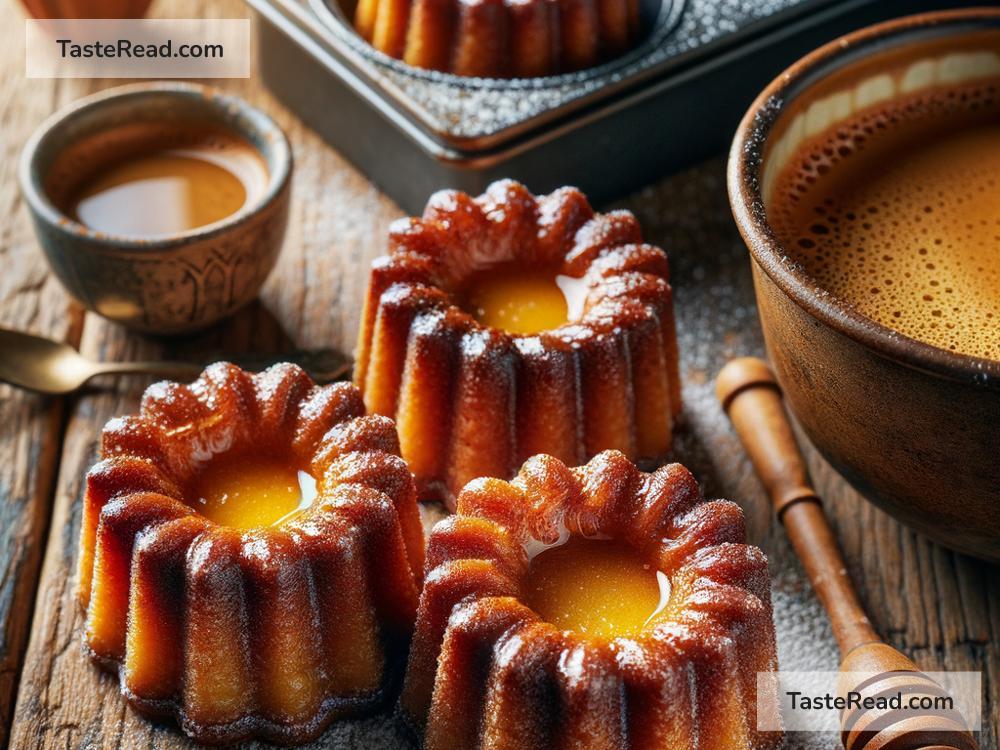The Story of French Canelés: A Sweet Tale from Bordeaux
France is famous for its delicious pastries and desserts, from buttery croissants to creamy éclairs. But tucked away in a tiny corner of French culinary history is a sweet treat that deserves the spotlight: the canelé (pronounced “kan-uh-lay”). This small yet mighty dessert, with its golden crust and soft, custardy center, comes from the region of Bordeaux. It’s a pastry that’s been loved for centuries, and its story is as fascinating as its unique flavor.
What is a Canelé?
A canelé is a small, cylindrical cake with a rich, caramelized crust and a tender, vanilla-flavored inside. It’s made primarily from humble ingredients: milk, eggs, sugar, flour, vanilla, and rum. The batter is baked in special molds made of copper or silicone, which give canelés their signature fluted shape. To achieve their perfect balance of textures—a deep caramelized exterior and a soft, custard-like center—the baking process is slow and precise.
The Origins: From Nuns to Noblemen
The history of canelés dates back hundreds of years, and like many food stories, it’s surrounded by myth and mystery. It’s believed that canelés originated in Bordeaux during the 18th century, possibly created by nuns in the city’s convents. The nuns may have used leftover egg yolks to make the cakes after wine merchants donated egg whites to clarify wine. Bordeaux, known for its famous vineyards, relied heavily on egg whites in winemaking, leaving the yolks behind—a perfect opportunity to invent a dessert.
Another theory links canelés to sailors who brought vanilla and rum from overseas trade routes. These exotic ingredients found their way into Bordeaux’s kitchens, where they became essential for the canelé recipe. It’s thought that bakers and chefs began experimenting, combining local ingredients and global flavors to create what is now one of France’s most cherished desserts.
During the French Revolution, many convents were closed, and the production of canelés slowed down. But the recipe survived, passed down through generations of bakers and families in Bordeaux. By the late 19th century, the canelé had returned to the city’s bakeries and markets, becoming a beloved local treat.
How Did Canelés Get Their Iconic Molds?
One of the most intriguing parts of the canelé story is its mold. The dessert is baked in special fluted molds that give it its distinctive scalloped pattern. Traditionally, these molds were made of copper, a material that conducts heat evenly and helps achieve the perfect caramelized crust. The molds are brushed with beeswax or butter before baking, adding to the dessert’s crispy texture and glossy finish.
The exact reason for the mold’s unique shape remains a mystery. Some say it mimics the shape of barrels used for Bordeaux wine production, while others believe the design was simply a creative choice by early bakers. Regardless, the mold became essential for making canelés, and today, the dessert is easily recognized by its elegant ridges and deep golden color.
From Local Secret to Global Fame
For many years, canelés were a humble, somewhat overlooked dessert. They were enjoyed by locals in Bordeaux but weren’t widely known outside the region. However, in the 20th century, canelés started gaining popularity. Chefs and bakers began making them in high-end restaurants and patisseries, showing off their technical skills with this challenging dessert.
Bakers across France worked hard to perfect the recipe, as canelés are notoriously tricky to make. The baking process demands precision: bake them too long, and the inside dries out; bake them too little, and the crust won’t caramelize. Additionally, maintaining the canelé’s distinct shape and texture requires a careful balance of temperature and timing.
Thanks to their growing fame, canelés traveled beyond Bordeaux and became a symbol of French pastry culture. Today, they can be found in bakeries across France and in international cities like New York, Tokyo, and London.
A Bite of Bordeaux
Despite their global popularity, canelés remain a proud symbol of Bordeaux’s heritage. They are often paired with a glass of wine from the region, creating a perfect marriage of flavors that reflects Bordeaux’s culinary traditions. Whether enjoyed as an afternoon snack or served as dessert at formal dinners, canelés hold a special place in the hearts (and stomachs) of locals and visitors alike.
Why Do People Love Canelés?
What makes canelés so special? Perhaps it’s their contrast of textures: the crisp, almost crunchy caramelized crust gives way to a soft, custardy inside. Or maybe it’s their delicate yet bold flavor, with notes of vanilla and rum that pair beautifully with coffee, tea, or wine. There’s also something magical about their appearance—the shiny, dark brown exterior with ridges that look almost like art.
For many, canelés represent more than just a dessert. They’re a connection to history, culture, and tradition. It’s amazing to think that such a small pastry carries with it centuries of stories from Bordeaux’s vineyards, convents, and bakeries.
Conclusion
The story of French canelés is a sweet reminder of how simple ingredients can create something extraordinary. From their mysterious origins to their elegant molds and global fame, canelés have enchanted dessert lovers for generations. If you ever find yourself in Bordeaux—or spot these little cakes in a bakery near you—be sure to try one. With each bite, you’re tasting a piece of history, culture, and the timeless magic of French pastry-making.


